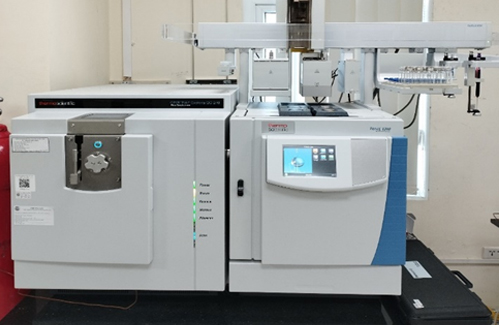- Folder Chemical field
- Views 746
- Last Updated 22/04/2022

HPLC instruments at Laboratory of Nutrients and Food Additives (NIFC)
1. Principle
Chromatography is the process of separating in the column with the stationary phase as a solid and the mobile phase as a liquid (liquid - solid chromatography). The samples are prepared to a solution, then transferred to a column. When analysing, analytes are distributed between the mobile phase and stationary phase. Analytes should interact differently with mobile phase and stationary phase based on their molecular structure and physical - chemical properties. Therefore, each analyte can pass through the column with each speed and be separated.
- HPLC system structure

A HPLC system has three main parts:
- Mobile phase and samples
- Column and pre-column
- Detector and computers
Stationary phase
Stationary phase in HPLC is a column packing particles that are responsible for separation of analytes. The particles are solid, porous with a small size from 3 to 7µm. Depending on the nature of the stationary phase, liquid chromatography is usually divided into two types: normal phase chromatography (NP-HPLC) and reverse phase chromatography (RP-HPLC).
- Normal phase chromatography: surface of particles is polar substances (that is bare silica or silica bonded with low carbon alkyl groups with polar functional groups: -NH2, -CN ...). The solvents are non-polar organic solvents such as n-hexane, toluene ... This system can separate various non-polar or less polar substances.
- Reverse phase chromatography: the stationary phase usually is alkylated, non-polar silica. The most common structure is –C18H37. Mobile phase is a mixture of polar solvents: water, methanol, acetonitril,.... In many cases, the main component of mobile phase usually is water, which is economical. This system is used to separate substances which are polar, or relatively polar.
Mobile phase
- Mobile phase generally has requirements:
- No reaction to stationary phase
- No decomposition in analytical conditions
- Dissolution analytes
- High purity
- Low viscosity and detector suitability
- Affordable
A suitable mobile phase is a solvent or solvent mixture that can separate analytes. A suitable mobile phase needs appropriate polarization, detector suitability as well as other properties such as the complexing forming.
Mobile phase can be divided into 2 types: high-polar mobile phase and low-polar mobile phase
The former has water as main component. However, determination of organic analytes requires adding another organic solvents to equalise polarity. This type of mobile phase suits to reverse phase chromatography.
The latter has non-polar or low-polar solvents, such as cyclopentane, n-pentane, n-hexane, 2-chloropropane, carbon disulfide, chlorobutane, Tetrachloromethane, toluene,... A mobile phase, which has one component does not usually meet requirements to elution capacity. Therefore, a mixture of 2 or 3 organic solvents can be used as a suitable mobile phase to analyse complex matrix samples because of its low to high polarity.
Changes in the composition of mobile phases can appear following the time, that can be called gradient elution.
Types of Detector
Detector is a important part which determines the sensitivity of method. Type of detector needs choosing based on physicochemical properties of analytes.
- UV-Vis molecular absorption Detector can be applied to analyse substances absorbable lights in range of UV (ultraviolet) or Vis (visibility).
- RF fluorescence detector can be used to analyse fluorescent analytes. In case of non-fluorescent analytes, a derivatisation or a reaction to bond the analytes to fluorescent chemicals can be performed.
- Conductivity detector can be used to analyse electrochemical substances and transition metal ions,...
Detectors have been upgraded nowadays as diode array (PDA), MS to improve the sensitivity and accuracy of determination method. Furthermore, thanks to advances in information technology, researchers can analyse following standard programs and perform a plenty of samples automatically.
2. Applications of HPLC systems in Department of Nutritions and Food Additives
In department of nutritions and food additives, there are more than 5 HPLC system with diverse type of detector: UV-Vis, PDA, FLD, RI; which are used to analyse nutrients and additives
- Nutriens
- Oil-soluble Vitamin: vitamin A (retinol, retinyl palmitate…), carotene (total carotene, beta-carotene), vitamin D (D2, D3), vitamin E (alpha tocopherol, tocopheryl acetate, beta-tocopherol, gama-tocopherol, delta-tocopherol), vitamin K3
- Water-soluble Vitamin: group B vitamins (B1, B2, B3, B5, B6, B9), vitamin C (acid ascorbic, ascorbyl palmitate, ascorbyl glucoside, ascorbyl phosphate).
- Sugar (glucose, fructose, saccharose, lactose,…)
- Food additives
- Preservatives: benzoic acid và its salts, sorbic acid and its salts, BHA, BHT, TBHQ,...
- Chemical sweeteners: aspartame, saccharin, acesulfam K, cyclamate…
- Low-energy sweeteners: sorbitol, isomalt, maltitol, erythritol, xylitol, mannitol…
- Natural sweeteners: steviol glycosides
- Chemical colourants: tartrazine, amaranth, sunset yellow, carmoisine, carmine, brilliant blue, fast green, erythrosine, ponceau 4R…
- Natural colourants: curcumin, riboflavin, anthocyanin…
- Acid-base adjustments: acid formic, acid acetic, acid propionic, acid butyric, acid lactic, acid oxalic, acid citric…
- Flavour enhancers: mono natri glutamate, inosilate, gualynate…










-cua-hang-Waters.jpg)








